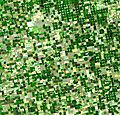Intensive farming facts for kids
Intensive farming or intensive agriculture is a way of growing crops or raising animals that uses a lot of effort, money, and technology. The main goal is to produce as much food as possible from a small area of land. This often involves using special chemicals like pesticides for plants and medicines for animals. It's different from older farming methods that didn't produce as much food per field. Intensive farming helps feed many people, but it also has some challenges, like concerns about animal welfare and pollution.
Modern intensive farming for crops often uses machines for ploughing, chemical fertilizers, and plant growth helpers. It relies on lots of farm machines. These machines have greatly increased how much food can be grown. However, they have also increased pollution by causing erosion and putting chemicals into water.
Contents
How Farming Changed Over Time
Early Improvements in Britain
For hundreds of years, from the 1500s to the mid-1800s, farming in Britain got much better. Farmers learned new ways to grow more food. This helped the population grow because there was more food for everyone.
The Industrial Revolution's Impact
The Industrial Revolution brought big changes to farming. By the early 1800s, farming tools, seeds, and plant types had improved a lot.
New Machines for Farms
Machines pulled by horses, like the McCormick reaper, made harvesting crops much faster. Other inventions, like the cotton gin, made it cheaper to process crops. Around the same time, farmers started using threshers and tractors powered by steam. In 1892, the first tractor that ran on gasoline was made. Later, mechanical harvesters, planters, and other equipment were developed. These inventions helped farmers grow more food and manage bigger farms.
Discoveries in Plant Nutrition
Scientists found that Nitrogen, phosphorus, and potassium (NPK) were very important for plant growth. This led to making artificial fertilizers. These fertilizers helped crops grow even bigger and faster.
Better Animal Care
In the early 1900s, people discovered vitamins and how they help living things. This led to vitamin supplements. By the 1920s, some livestock could be raised indoors. This protected them from bad weather.
After World War II, farmers started using a lot more artificial fertilizers. Also, the discovery of antibiotics and vaccines helped keep farm animals healthier by reducing diseases. New ways to keep food cold, like refrigeration, and better food processing made it possible to transport food over long distances.
Modern Concerns About Farming
Today, some people worry about whether industrial farming can continue forever. They are also concerned about how fertilizers and pesticides affect the environment. Because of these worries, more people are buying organic food. This has also led to money being spent on developing more sustainable farming methods.
What Makes Intensive Farming Different?
Intensive farming has several key features:
- It needs a lot of capital or money to start and run.
- It uses many farm chemicals, such as pesticides and fertilizers.
- Farmers use improved types of crops and animals that produce more.
- It creates a lot of extra food to sell.
- It uses modern farming methods and big machines.
- It is usually done on very large areas of land.
- It relies on skilled labour to operate complex machinery and manage the farm.
- It produces very high amounts of food from the land used.
Images for kids
-
Early 20th-century image of a tractor ploughing an alfalfa field
-
Satellite image of circular crop fields in Haskell County, Kansas, in late June 2001. Healthy, growing crops of corn and sorghum are green (sorghum may be slightly paler). Wheat is brilliant gold. Fields of brown have been recently harvested and plowed under or have lain in fallow for the year.
-
Terrace rice fields in Yunnan Province, China
See also
 In Spanish: Agricultura intensiva para niños
In Spanish: Agricultura intensiva para niños








